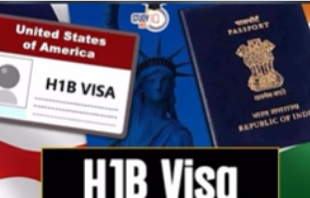– Mohd. Ziyaullah Khan
Nagpur
The drama began on September 20, 2025, when US President Donald Trump signed a sweeping executive order on immigration reform. What truly sent shockwaves across India’s technology sector, however, was Commerce Secretary Howard Lutnick’s announcement: a $100,000 H1B visa fee hike.
His words, especially the mention that the fee would apply “every year,” created instant chaos. Many assumed the new policy would affect not only future applicants but also the 300,000-plus Indians already working in the US on H1B visas. Let us understand the panic that seemed to have come up with this news along with the policy and getting the perspective behind this decision in this article.
Initial Panic in India’s Tech Corridors
Just when the Prez Donald Trump issued this statement, within hours, WhatsApp groups lit up with frantic messages. Indian professionals vacationing in India rushed to book tickets back to the US, worried about their status. Aspiring engineers and students feared their American dream had just been priced out of reach.
In a sense, the IT industry, particularly TCS, Infosys, and Wipro, was seen with a big jolt. These IT firms, which depend heavily on H1B visas to send engineers onsite to US clients, suddenly faced the possibility of dramatically higher costs. However, amidst the uproar, not everyone was seen panicking.
The Voice of Reason Amid the Chaos
If you ask any Indian Professional working in the US, he or she would claim, “People panic whenever H1B is mentioned.” Perhaps, every other Indian professional working in New York on a non-immigrant visa would say similar thing. A few who would love to maintain their anonymity would offer a contrarian perspective to the doom-and-gloom narrative dominating conversations.
The confusion, they would explain, would arose because some Lutnick sitting on the top said the hike would apply “every year.” Only later did the US Citizenship and Immigration Services (USCIS) clarify that the new fee would apply only to new applications from FY 2027 onward, not to existing visa holders. “This is just panic. It really isn’t impacting anybody here,” they would say on this situation.
Who Will Actually Be Affected?
Now, the big questions, who are the ones who would be affected the most? The proposed policy means companies will pay $100,000 for each H1B petition filed from outside the US, starting FY 2027. This directly impacts Indian IT giants that hire large batches of engineers in India and send them abroad.
However, as per the IT professionals pointing out, the policy does not affect:
- Indians already working in the US on H1B visas.
- Students graduating from US universities who apply for H1B status.
For these groups, the American dream is still intact.
A Contrarian’s Analysis
Many of the Indian professionals would see the fee hike as an unexpected advantage for current H1B holders. “This actually benefits us who are already in the US,” he insists. With fewer new entrants from abroad, existing workers may face less competition. They criticise the tendency of the community to react before verifying facts: “A lot of people react before they understand. That’s the problem.”
The Guest Worker Reality Check
Perhaps most striking is the IT professionals’ acceptance of America’s right to set immigration rules. “You’re a guest there,” he says. “If they don’t feel comfortable, you have to step out.”
For them, complaining about restrictions is misguided: “I can’t expect someone coming to India to demand opportunities. It’s the same here.”
They believe talent will prevail: “If you have real talent, it doesn’t matter where you are. If tomorrow I have to leave, I’d be happy to do that.”
Beyond Visas: Trade and Geopolitics
Looking beyond immediate anxieties, most of the Indian professionals view the policy through a geopolitical lens. “This is where trade agreements and international politics come in. We have to wait and see what the Indian government does.”
He reminds that H1B is just one visa category. Indians also work on L-1, O, and J visas, making the larger picture more complex than headlines suggest.
“H1B is hyped because big companies use it the most. But it’s not the only route.”
The Domino Effect of Policy Change
Many Indian professionals admit that any policy change in a globalised world creates ripple effects. “It’s like dominoes – one move leads to many consequences, good or bad.”
Yet, they warn against media sensationalism and misinformation, which amplify fear. “When you share messages without due diligence, it creates false panic. Whether intentional or not, it spreads fear.”
Their advice: “Tell only what you know. Don’t exaggerate.”
The Bigger Lesson
The $100,000 H1B fee proposal highlights the fragility of dependency on foreign work visas. For Indian IT companies, it may mean rethinking business models. For aspiring migrants, it’s a reminder of the uncertainty of immigration policies.
For most of the Indian professionals, however, the lesson is to stay grounded: “Policies will change, governments will change. If you have skills, you’ll find your place.”
Conclusion
Whether the fee hike turns out to be a serious barrier or simply a speed bump will depend on how it’s implemented and how India and its tech industry respond. As of now, though, many of the Indian professionals’ calm analysis only offer a refreshing counterpoint to panic. In their words: “The sky isn’t falling. We just need to wait, watch, and adapt.”
So, at the moment, it is all about waiting and watching as we see the storm around the said visa is blown out of proportion by the panic population back in India. While many even celebrate stating that the country will now see a decline of brain drain, which may appear to be a wishful thinking of the people who are sitting in the government and literally doing nothing.
[Mohd Ziyauallah Khan is a freelance content writer & editor based in Nagpur. He is also an activist and social entrepreneur, co-founder of the group TruthScape, a team of digital activists fighting disinformation on social media.]




